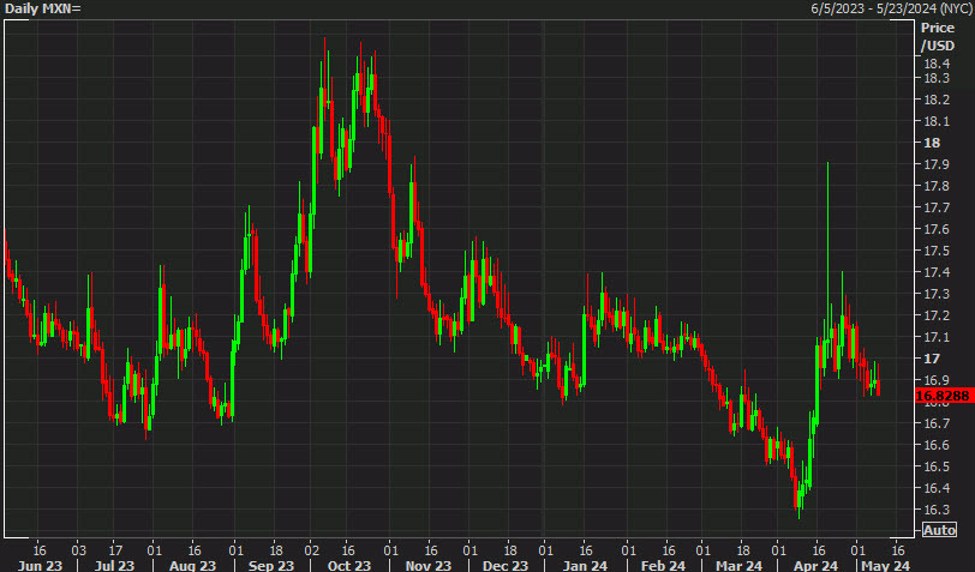Kevin Dietsch/Getty Images News
Investment Thesis
I believe that Meta’s (NASDAQ:META) recent earnings report reveals their growth prospects with their AI segment through the newly launched Llama 3 AI model, in what, I believe, will be later looked at as a ChatGPT moment for the social media giant. The company aims to use their new LLM to help improve user experiences across Meta’s platforms (Facebook, Instagram, and WhatsApp), and improve ad targeting and personalization to drive higher ad sales by monetizing their vast user base across various platforms. I think this is big (more on this later).
With this, the tech giant’s revenue rose 27% YoY to $36.46 billion in Q1 2024 and expects around $36.5 billion to $39 billion next quarter.
I am optimistic about this since Meta continues to expand their AI capabilities, and is now more aggressive in terms of partnerships with major tech firms to integrate Llama 3 into third-party enterprise solutions. The company’s Q1 2024 revenue boost is their fastest rate of expansion for any quarter in three years, and I believe that their capability to catch up on the growing demand for AI technologies make them a strong buy for forward-looking investors seeking exposure to the tech leader’s pursuit of earnings in the AI industry.
Why I Am Doing Follow-Up Coverage
In February 2024, I positioned Meta as a strong buy (up from a hold). The company may have easily beaten forecasts with their impressive sales uptick, a $12.4 billion net income, and a surprising $4.71 earnings per share but, the stock’s returns have trailed the market due to investor concerns over the company’s announced capital expenditures (capex).
The current trend is pointing towards more capital spend to position their AI efforts more aggressively against OpenAI’s GPT-4. Total spend, for instance, is projected to reach $35-40 billion in order to help the firm improve the company’s product development and infrastructure. These costs are projected to balloon more as we head into next year. According to CEO Mark Zuckerberg during the company’s earnings conference call:
As we scale capex and energy expense for AI, we’ll continue focusing on operating the rest of our company efficiently. But realistically, even with shifting many of our existing resources to focus on AI, we will still grow our investment envelope meaningfully before we make much revenue from some of these new products – Q1 2024 earnings call
While I believe that the company’s large investments in AI investments will slowly pay off, I can understand why the street has pushed the stock to underperform since. Total expenses in 2024 to hover around $96 billion to $99 billion. More so, their capital spending is projected to be around $5 billion more than earlier projections – all for their goal to take leadership in AI. Still, investors need to trust Zuckerberg with his bold spending decisions, and I do as well. Increased spend is for sure nerve-wracking as an investor, but genuinely see this as a catalyst for the company to be more efficient with current product lines, plus eventually generate another line of revenue.
The key reason I am writing this update is that I believe Wall Street is misunderstood. Meta stock dropped post earnings like every dollar spent on Capex was going to be a waste (and therefore lower the net present value of the company). I think this is backwards: I believe every dollar invested in AI capex will be a major net benefit for the company eventually. Last quarter, I believe it was clear to Wall Street the value of the AI revolution Meta was participating in. This quarter, I think Wall Street is not getting its head around the costs associated to capture the value that AI will bring.
Earnings Are Key To The Story
Meta’s Q1 2024 earnings call is highlighted by their strong revenue growth with investments in AI and metaverse technologies that are gradually driving future growth through the power of AI transformation across their apps and new business segments. Zuckerberg stressed a strong start to the year with significant user engagement across Meta’s applications. In particular, WhatsApp has started to gain momentum in the U.S.
Overall earnings of $4.71 beat estimates by $0.35. Overall revenue of $36.5 billion beat by $231.89 million.
The company is more focused on advancing their AI and Metaverse initiatives with the rollout of Meta AI, powered by the new Llama 3 model, which has been well-received so far. This AI model is expected to improve user interaction across Meta’s platforms and feature animation from still images and real-time image generation.
Capital expenditures were $6.7 billion due to investments in data centers and network infrastructure to scale AI capabilities. Meta’s effective tax rate for the quarter was 13%, generating the net income of $12.4 billion or $4.71 per share I mentioned before.
The earnings call also detailed Meta’s deep investment in AI and gadgets, with Zuckerberg mentioning Meta’s AI developments and their Metaverse ambitions, particularly in AR glasses and AI integration.
Finally, he assured investors that the need for more spending is necessary (I think this was key):
This leads me to believe that we should invest significantly more over the coming years to build even more advanced models and the largest scale AI services in the world. As we’re scaling capex and energy expenses for AI, we’ll continue focusing on operating the rest of our company efficiently. But realistically, even with shifting many of our existing resources to focus on AI, we’ll still grow our investment envelope meaningfully before we make much revenue from some of these new products – Q1 2024 earnings call.
This leads me to what matters with this statement: Zuckerberg recognizes (and I believe as well) that having a powerful in-house built LLM will allow Meta to best serve content and ads to users in a way that only a powerful tool in-house can (vs. an API usage of an outside model like OpenAi’s GPT4).
I wrote about this in my last piece, but to recap: user engagement is down on Facebook since 2016. From what I said in February:
(Facebook) is down from 2017. In 2017, users used to spend 41 minutes a day on Facebook. The New York Times in 2016 noted users used to spend 50 minutes a day. Now it’s only 30 minutes per day. I believe AI can help reverse this declining trend and help Meta serve more ads per user per day. In my opinion, it’s not unreasonable to see average user engagement on the platform converge back to 50 minutes a day, meaning a 67% increase in daily activity (and opportunities for ads served). -February Analysis.
Now with Llama 3, Meta’s ability to further refine user engagement to serve them more ads effectively is going to jump even further. Meta is unlocking more revenue by getting each user to spend more time on the platform. AI is the centerpiece of this. It’s no wonder that he is spending more on Capex.
What I Saw On The Earnings Call To Show AI Is Working
At the heart of my assumption (and Zuckerberg’s bet on AI) is the following statement: can investments in AI by Meta (especially through capex spend) cause the company to experience disproportionate gains?
While early, I think the answer is easily yes.
AI has also been a huge part of how we create value for advertisers by showing people more relevant ads. And if you look at our two end-to-end AI powered tools, Advantage+ shopping and Advantage+ app campaigns, revenue flowing through those has more than doubled since last year. -Q1 Call
Right now, about 30% of the posts on Facebook feed are delivered by our AI recommendation system. That’s up 2x over the last couple of years and for the first time ever, more than 50% of the content that people see on Instagram is now AI recommended. -Q1 Call.
I think these quotes are critical. They show that there is real benefit from all the AI spend (even though we are still so early in the payoff cycle).
From a balance sheet perspective, Meta is ripe to support this flywheel effect with AI investments even further. The company still sports over $58 billion in cash and short-term investments. On top of this, net PPE (property, plant and equipment which is what AI server equipment is classified as) only increased by a net of roughly $2.6 billion last quarter. Meta is already seeing exponential benefit with AI with just net PPE investments that are a fraction of what they committed to invest this year. I think this is a really powerful statement for what’s to come (in terms of innovations).
Valuation
Based on their strong advancements with their LLMs, I believe Meta is a strong buy with a promising future in the AI market. I am not the only one who thinks this, in fact, I believe even after the drop post earnings, the market agrees with me. When looking at their forward price-to-earnings (P/E) ratio on a non-GAAP basis, Meta stands at 23.27, which is 69.54% higher than the sector median of 13.73. In addition, their forward price-to-sales (P/S) ratio is 7.44, markedly higher by 512.19% compared to the sector median of 1.22.
Although the metrics listed (I believe) demonstrate that the market values Meta at a premium already for their strong business model, I actually think shares are not valued high enough. I believe that Meta deserves to be traded at the same multiple as their indirect AI competitor, Microsoft (Microsoft is selling AI tools to businesses, Meta is using them in house to develop stronger user retention).
Despite Meta’s recent stock decline, I believe there is still a strong upside potential for investors. Currently, Meta’s forward price to sales multiple is 7.44, which is much lower than their close competitor Microsoft (MSFT), which sits at 12.55.
Again, to emphasize, I think Meta deserves to trade at such a high price to sales multiple for the following reasons:
-
Meta is using their new LLMs to increase engagement time users have on their platform and serve better ads (might be one of the world’s largest optimization experiments ever, with over 3 billion people in the experiment).
-
This platform becomes irreplaceable to the small businesses that use it to market their products on, (and get the best in class optimized ad spend) coupled with a platform that best understands its users meaning the content is most refined to each user’s taste. AI can (and I believe will) help with both of these.
If we see Meta’s price to sales multiple coverage on Microsoft’s, my upside estimates for Meta are around 68.7% from here (current stock price). Despite the lack of short-term ROI due to heavy capex investments, I believe in the long run, Meta is a strong buy, and therefore is still being undervalued within the market.
Why I Think They Deserve To Trade At Such A High Multiple
While the forward Price to Sales Ratio I am arguing for is much higher than what they currently trade for, I think we need historical context for this. Meta used to trade at a price to sales ratio as high as 18.38 in 2013 when they were early in their growth cycle. I think as we see the effects of AI cause an acceleration, this should be able to accelerate growth again, causing their forward Price to Sales ratio to re-rate higher.
Where This Stands Compared To My Previous Valuation Estimates
In February, I argued that the company had 36% upside, given I believed they deserved a higher P/E ratio.
Since then, the stock is about flat (up 0.90%) underperforming the market (up 3.30%). I see the upside now as 68.7% due to the seriousness of this capex spend and the already promising early engagement improvements we are seeing as of the Q1 call. I believe Zuckerberg is investing for massive growth, and I think this increased the opportunities for Meta (and with this the upside).
Risks To Thesis
There’s no doubt that the primary risk for Meta is Zuckerberg’s forewarning of stock volatility. He expressed, in no uncertain terms, that the very ambitious AI investments will last for years. So, investors should brace for more volatility in the stock price as we head into the end of the year when there’s barely any direct monetization from their product developments (I do think we will see in-direct through ad and content optimizations, however).
This, in my opinion, is one way of guaranteeing investors that Meta is going to stand their ground in an investing arms race to capture significant GPU power and some of the best talent for their models. Note, by the way, that heavy capex has become common among tech players since the rapid growth of AI. Microsoft’s $100 billion project, for example, that will be used to build a specialized AI datacenter with OpenAI, is more than three times that of what they spent on capex last year.
Alphabet, on the other hand, will also invest the same amount ($100 billion) for AI projects, although they did not specifically disclose what these will be.
What I believe makes this risky is that many investors would prefer seeing ROI from these investments in the short term, but there’s nothing quantifiable to report so far.
Takeaway
Meta’s forward-looking strategy positions themselves to better capitalize on the growing demand for advanced AI and virtual reality applications both externally and internally for themselves. However, it’s important to address concerns over the substantial capex forecast.
I believe that despite the near-term financial pressures from high capex and the stock’s plunge afterward, Meta’s strategic AI-focused direction presents the case for a strong buy recommendation. The company’s investments, however slow in short-term ROI, are needed to prepare the groundwork for their future growth for the most patient investors.
Meta’s intensive investment phase, I think, offers a huge potential for market-disrupting innovations in AI for end users and businesses. I believe investors should focus on Meta’s long-term growth narrative, which remains robust despite short-term volatility and capex burdens.















